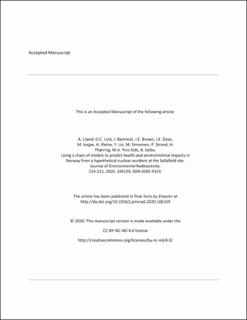| dc.contributor.author | Liland, Astrid | |
| dc.contributor.author | Lind, Ole Christian | |
| dc.contributor.author | Bartnicki, Jerzy | |
| dc.contributor.author | Brown, Justin | |
| dc.contributor.author | Dyve, Jan Erik | |
| dc.contributor.author | Iosjpe, Mikhail | |
| dc.contributor.author | Klein, Heiko | |
| dc.contributor.author | Lin, Yan | |
| dc.contributor.author | Simonsen, Magne | |
| dc.contributor.author | Strand, Per | |
| dc.contributor.author | Thørring, Håvard | |
| dc.contributor.author | Ytre-Eide, Martin Album | |
| dc.contributor.author | Salbu, Brit | |
| dc.date.accessioned | 2020-09-28T06:40:02Z | |
| dc.date.available | 2020-09-28T06:40:02Z | |
| dc.date.created | 2020-09-07T12:49:50Z | |
| dc.date.issued | 2020 | |
| dc.identifier.citation | Journal of Environmental Radioactivity. 2020, 214-215, 106159. | en_US |
| dc.identifier.issn | 0265-931X | |
| dc.identifier.uri | https://hdl.handle.net/11250/2679807 | |
| dc.description | Embargo until 23 January 2022 | en_US |
| dc.description.abstract | When a nuclear accident occurs, decision makers in the affected country/countries would need to act promptly to protect people, the environment and societal interests from harmful impacts of radioactive fallout. The decisions are usually based on a combination of model prognoses, measurements, and expert judgements within in an emergency decision support system (DSS). Large scale nuclear accidents would need predictive models for the atmospheric, terrestrial, freshwater, and marine ecosystems, for the connections between these in terms of radionuclide fluxes, and for the various exposure pathways to both humans and biota. Our study showed that eight different models and DSS modules could be linked to assess the total human and environmental consequences in Norway from a hypothetical nuclear accident, here chosen to be the Sellafield nuclear reprocessing plant. Activity concentrations and dose rates from 137Cs for both humans and the environment via various exposure routes were successfully modelled. The study showed that a release of 1% of the total inventory of 137Cs in the Highly Active Liquor Tanks at Sellafield Ltd is predicted to severely impact humans and the environment in Norway if strong winds are blowing towards the country at the time of an accidental atmospheric release. Furthermore, since the models did not have built-in uncertainty ranges when this Sellafield study was performed, investigations were conducted to identify the key factors contributing to uncertainty in various models and prioritise the ones to focus on in future research. | en_US |
| dc.language.iso | eng | en_US |
| dc.publisher | Elsevier | en_US |
| dc.rights | Attribution-NonCommercial-NoDerivatives 4.0 Internasjonal | * |
| dc.rights.uri | http://creativecommons.org/licenses/by-nc-nd/4.0/deed.no | * |
| dc.title | Using a chain of models to predict health and environmental impacts in Norway from a hypothetical nuclear accident at the Sellafield site | en_US |
| dc.type | Peer reviewed | en_US |
| dc.type | Journal article | en_US |
| dc.description.version | acceptedVersion | en_US |
| dc.source.pagenumber | 15 | en_US |
| dc.source.volume | 214-215 | en_US |
| dc.source.journal | Journal of Environmental Radioactivity | en_US |
| dc.identifier.doi | 10.1016/j.jenvrad.2020.106159 | |
| dc.identifier.cristin | 1827755 | |
| cristin.ispublished | true | |
| cristin.fulltext | postprint | |
| cristin.qualitycode | 1 | |

